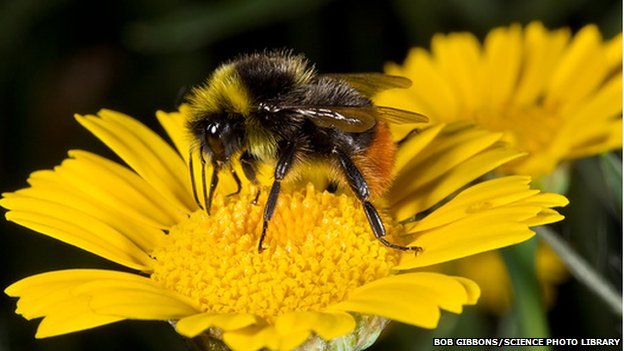New threats to wild bees identified
- Published

Wild bumblebees are infected with many of the diseases found in honeybees looked after by bee keepers, according to a national survey.
With wild bees already under threat from habitat loss and pesticides, diseases could have a profound impact on populations, say scientists.
In Britain, bumblebee species are declining, and two have become extinct.
Conservation groups are calling for tougher regulations on importing bees for commercial use.
Researchers at Royal Holloway, University of London, collected hundreds of free flying honeybees and wild bumblebees in 26 areas of England, Wales and Scotland.
Analysis revealed that five common viruses which cause disease in honeybees are circulating in bumblebees.
More needs to be done to protect both wild bees and commercial honeybees, said a team led by Prof Mark Brown of the School of Biological Sciences at Royal Holloway, University of London.
"Our findings reveal the widespread prevalence in wild bee populations of multiple RNA viruses previously associated with honeybees," the researchers report in the Journal of Animal Ecology.
Together with other environmental factors, such as habitat loss and pesticides, diseases could have a "profound impact on the long-term health of bee populations," they said.
Practical measures
In the UK there are 24 species of bumblebee but only eight are commonly found in most regions. Bumblebees have been declining due to a shortage of flowers to feed on and places to nest in the countryside.
Native honeybees living in the wild have largely disappeared, due to diseases and mites, such as the Varroa mite.
However, many honeybees looked after by bee keepers forage in the countryside and urban habitats, where they may come into contact with wild bumblebees.
Vanessa Amaral-Rogers of the insect charity Buglife said diseases found in honeybees were another factor to consider in bumblebee conservation.
"We need to consider the use of pesticides, increasing food resources so planting more wild flowers for all our pollinators, but also the diseases that are being brought in and transmitted between wild and managed bees," she said.
The research adds to growing evidence that multiple environmental pressures are driving the loss of bees in the wild and in hives.
In a review of evidence published last week in the journal Science, biologists at the University of Sussex called for practical measures to protect bees including:
- incorporating flower-rich habitat into farmland
- reducing pesticide use
- bringing in quarantine measures for bees shipped from country-to-country
- better monitoring of wild bee populations.
Follow Helen Briggs on Twitter.
- Published15 July 2014